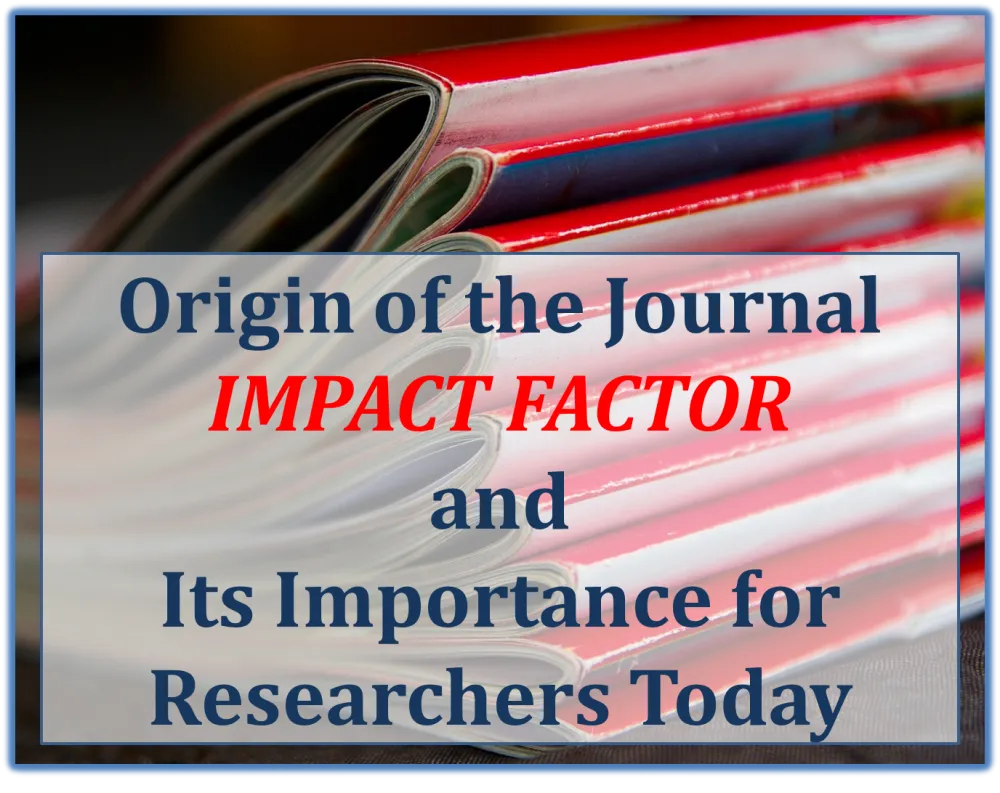Origin of the Journal Impact Factor and Its Importance for Researchers Today
Alyssa Colton, Ph.D. | Oct. 31, 2016

As a new or aspiring author of a scientific paper, you may have heard the term “impact factor.” The impact factor (IF) is an important but somewhat controversial concept in scientific publishing. Researchers should be acquainted with this term, what it is, how it is used, how it should be used, and what alternative metrics are available.
So, what is the impact factor?
The impact factor is a metric used to rank journals. The primary purpose, according to Thomson Reuters, which publishes the database of journal impact factors, is for library management, but it’s also used for marketing (1994). Researchers use the impact factor to determine which journals might be the best place to submit their work, based on the impact factor, to ensure its visibility. A higher impact factor usually correlates with higher status in a field of study.
How did the impact factor arise?
The impact factor arose out of a need to rank journals based on their importance or impact. The impact factor can reveal patterns about which journals are cited in the research and how often.
Eugene Garfield, an information scientist, first proposed the idea for such a metric in an issue of Science in 1955. Garfield later developed the impact factor in the 1960s with his colleague, Irving Scher, in an attempt to compare and rank scientific journals while accounting for differences in size and circulation (Garfield, 2005).
The database listing impact factors first appeared as the Science Citation Index and was published by the Institute for Scientific Information, which was founded by Garfield. It later became Journal Citation Reports (JCR), which is published by Thomson Reuters.
Receive Free Grammar and Publishing Tips via Email
How is the impact factor determined and what journals does it cover?
The number of citations to papers in a particular journal are counted over a two-year time span. This number is then divided by the total number of papers published by that journal over that time span.
Because of differences in pacing of research in different fields of inquiry, journals are only compared to other journals in the same field. Thus, medical journals will only be grouped with other medical journals, ecology journals will only be grouped with other ecology journals, and so on.
The resulting impact factor can vary widely depending on the type of research and the journal. The highest reported IF is 87.925, but the next highest is 50 (Benson and Silver, 2013).
The JCR is published in June for the preceding two years. An impact factor found in the 2016 database would reflect the two-year span of 2014-15. The JCR had over 9,000 journals listed in 2009 (Benson and Silver 2013). However, this is only about 25% of all journals published. It also skews toward English-language journals, so it is important to keep this in mind.
Why you may need to know an impact factor?
If you’re looking to submit a scientific paper, the impact factor can give you some information regarding the prestige of the journal, according to Garfield (2005). Getting published in a journal with a high impact factor is linked to more respectability and to advantages in hiring, tenure, promotion, and grant acquisition (Benson and Silver, 2013). It should not, however, be the only criteria used to evaluate a piece of work, a journal, or a researcher.
Journal editors have an interest in seeing their journals’ impact factors increase. Any journal editor who asks you to add more citations to their own journals’ articles are highly unethical and should be avoided. Remember that the impact factor is for information and research—it should not dictate the terms of your research.
Problems with the impact factor
Many critics, including Garfield, have pointed out that the impact factor has been used in inappropriate ways, such as for sole evaluation of candidates for employment. Impact factors should not be used to evaluate an individual author’s work. At the very least, impact factors should only be used alongside other forms of evaluation, such as an informed peer review.
It is also important to note that some journals with a low impact factor might actually be publishing some very important work, but because they are in a smaller field, they may receive fewer citations. That’s why comparing similar journals and using other measures is important.
In addition, because journals with high impact factors are more prestigious, they can be more difficult to publish in, with some having a rejection rate as high as 75% (Benson and Silver, 2013). If your goal is ultimately to be published, be sure to consider which journal is the best fit for your work using several criteria, not just the impact factor.
Check out our related post: Choosing the Best Journal for Your Paper: Top 5 Recommendations
Alternatives to the impact factor
Because of perceived issues with the impact factor, there are some alternatives. The three possibilities are: the h index, the Eigenfactor, and the SCImago Journal & Country Rank. These are briefly described below.
The h index was developed by the physicist Jorge Hirsch in 2005. It compares the number of papers published by an author with the number of citations to those articles. As such, it measures an author’s productivity.
The Eigenfactor, which is used by the Web of Science index, looks at the frequency of citations over a five-year period and measures a particular article’s influence on other research.
The SCImago Journal & Country Rank provides a database of journals using rankings and visibility that is organized by type and includes international publications. This is found in an abstract and citation database called Scopus, which is published by Elsevier.
So, now you know more about the impact factor. What’s next?
Understanding the impact factor and its significance is only one of many steps on the route to publishing your scientific paper. As mentioned, the impact factor should be used as only one piece of information to inform your decisions about submission and publication. Be sure to consider the suitability of your research article for a particular journal and compare that to its likelihood of getting published. It’s also important to consider your own goals and to get feedback from others. Falcon Scientific Editing provides full publication support, including journal recommendations, to any author that orders our services .
If you need more info about publishing your scholarly article, you may also like these posts:
Publishing in English-language journals
Publishing in an International Scholarly Journal: Tips from an Editor
Tips for International Authors Who Wish to Publish in English Language Journals
Get Published! Q&A with a Texas A&M Law Professor
References:
Benson, P. and Silver, S.C. What Editors Want: An Author’s Guide to Scientific Journal Publishing . Chicago: University of Chicago Press, 2013.
Garfield, E. The Agony and the Ecstasy--the History and Meaning of the Journal Impact Factor. Presentation at the International Congress on Peer Review and Biomedical Publication. Chicago. September 16, 2005. [Online.]
http://garfield.library.upenn.edu/papers/jifchicago2005.pdf?utm_source=false&utm_medium=false&utm_campaign=false (accessed October 17, 2016).
Thomson Reuters. The Thomson Reuters Impact Factor. [Online]. June 20, 1994.
http://wokinfo.com/essays/impact-factor/ (accessed October 17, 2016).
About the Author:
 Dr. Alyssa Colton has a Ph.D. in English from the University at Albany, State University of New York (SUNY). She has taught and worked with students of all levels and backgrounds on writing skills for 20 years. She is a freelance writer and editor specializing in science, health, productivity and career development.
Dr. Alyssa Colton has a Ph.D. in English from the University at Albany, State University of New York (SUNY). She has taught and worked with students of all levels and backgrounds on writing skills for 20 years. She is a freelance writer and editor specializing in science, health, productivity and career development.
Topics : Impact Factor
